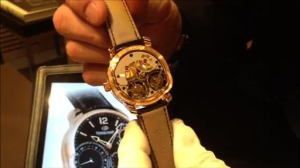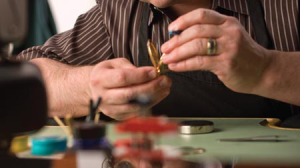Collecting antique pocket watches is a growing hobby in most parts of the western world. Men, particularly, are attracted by the romance and novelty of having a micro-engine on their wrist as both a time-teller and an instant conversation piece.
One of the most frustrating aspects of collecting vintage watches is the number of fakes, frankenwatches and fraudsters one encounters in pursuit of this noble, but increasingly costly, passion.
In a recent seven day survey and follow-up I completed on the listing of vintage Omega Constellation watches on a major on-line trading site, more than 50 percent of all listings were of watches that were inauthentic in some way – that gives you some idea of what collectors are up against.
Caveat Emptor, rarity and product knowledge steer the purchasing behaviours of astute collectors in any collecting field and these three principles are particularly important when purchasing vintage watches on-line and through brick and mortar dealers.
Frankenwatches describe the practice of taking parts from different watches of the same calibre series and ‘creating’ a hybrid or better pedigree of movement. In some countries of Europe they are called ‘Wedding’ watches. This practice is especially prevalent in middle and higher end timepieces that are most sought-after by collectors.
In tandem with the obvious deception of Frankenwatches, there are a number of other intentional and inadvertent frauds that occur:
1. Housing a different movement in a genuine case or re-dialed model. If you are interested in collecting a particlar brand of watch, get to know the calibre numbers of movements that power particular models. Calibre numbers are different than serial numbers and can best be described as the engine type(similar to cars: eg. 2.5-litre DOHC V6 describing the engine in a current X Type Jaguar). Some calibres of a particular brand are more collectible than others, so it pays to know what’s under the bonnet.
 2. Using a similar movement series and replacing the part that has the calibre number. This is prevalent in watch brands that have numerous models and where the top line models fetch higher prices than the cheaper models. Often you can tell a fraud of this type through colouration contrasts or newness of the parts that contains the calibre number.
2. Using a similar movement series and replacing the part that has the calibre number. This is prevalent in watch brands that have numerous models and where the top line models fetch higher prices than the cheaper models. Often you can tell a fraud of this type through colouration contrasts or newness of the parts that contains the calibre number.
3. Placing a high end dial and movement in a different case. Many of the higher end vintage watches have case back numbers that can be checked with serial numbers to see if they match.
4. Replacing worn hands and crowns with non-genuine hands and crowns and claiming the watch is 100 percent authentic. A common problem with many vintage models that reduces the value of the watch. Before buying, build up a library of pictures of watches that you know are genuine and match a prospective purchase against them. On-line forums are a great way to acquire and swap pictures.
5. Badly executed dials and re-dials. Ask for super-sized pictures so you can examine the quality of the printing and also the placement of lettering. A bad re-dial will wipe as much as 30 percent off the value of the watch. Again pictures and the help of other collectors is invaluable in making sure you have an authentic watch. Check out this Seiko mens watch gold that is stylish and functional.
 6. Replacing numerous worn parts in a genuine models with genuine parts. While this is a perfectly acceptable practice, it does indicate that at some stage in the life of the movement it was neglected or damaged. Knowledgeable and pernickety collectors look for signs of colour variation on the movement and often avoid watches that are not of one colour hue.
6. Replacing numerous worn parts in a genuine models with genuine parts. While this is a perfectly acceptable practice, it does indicate that at some stage in the life of the movement it was neglected or damaged. Knowledgeable and pernickety collectors look for signs of colour variation on the movement and often avoid watches that are not of one colour hue.
Look for scratches or gouges on the non-replaced parts, and look for corrosion or other signs of wear and tear. Ask a vendor such as a bust down Rolex watch seller for a detailed report on the history of servicing of the watch and its current condition. If the vendor cannot supply such information it is better to let the watch go rather than experience the disappointment of acquiring a watch that has suffered abuse in the past and having to deal with the ongoing symptoms of that abuse.
 7. Claiming an old warrior is a handsome prince. Many vendors use descriptions like ‘minty’, ‘100% authentic’, ‘very clean’, ‘this one is a keeper’, and so on. Most of these descriptions are useless if not backed up by evidence.
7. Claiming an old warrior is a handsome prince. Many vendors use descriptions like ‘minty’, ‘100% authentic’, ‘very clean’, ‘this one is a keeper’, and so on. Most of these descriptions are useless if not backed up by evidence.
When examining a good quality picture of the watch movement, and always ask for pictures if you are buying on the internet, look for any discolouration of the surfaces of plates and bridges. Look for any signs of corrosion or parts of the watch that do not match in colour, particularly rotor bridges and the part of the watch that contains the calibre or serial numbers. Look for new additions that show themselves by their shininess. These are all indicators of in authenticity, part swapping or at least major repairs.
 8. Examine the movement for burred screw heads and scrapes and damage to the movement plates or bridges, which are sure signs of inexpert work, or at least indicate the movement was separate from the case for some time before a case was found to match. Check for surface discoloration on the movement plates, blotches, corrosion, or parts that don’t match the rest of the movement patina.
8. Examine the movement for burred screw heads and scrapes and damage to the movement plates or bridges, which are sure signs of inexpert work, or at least indicate the movement was separate from the case for some time before a case was found to match. Check for surface discoloration on the movement plates, blotches, corrosion, or parts that don’t match the rest of the movement patina.
9. Examine the case back to determine whether the watch has had a hard life. Beware of excessive polishing that takes the sharpness away from the edges of the watch case, as that again indicates considerable wear and tear overall and devalues the watch.
10. A watch that has obviously had a hard life indicates carelessness towards its maintenance and irregularity in servicing. Generally speaking, mechanical watches should be serviced every three to five years, and it is not difficult to detect a watch that has been neglected because the signs of disregard are obvious to the naked eye.
 Badly discoloured watches with scratches, gouges to the movement, highly polished case backs and inexpertly refinished dials are sure signs of the amateur watchmaker at work and should be avoided. They can also point to a tired old movement jazzed up for sale and marketed with great hyperbole to the unwary Internet shopper.
Badly discoloured watches with scratches, gouges to the movement, highly polished case backs and inexpertly refinished dials are sure signs of the amateur watchmaker at work and should be avoided. They can also point to a tired old movement jazzed up for sale and marketed with great hyperbole to the unwary Internet shopper.
11. Look carefully at the dial to see if screws have caused minor or major indentations on the dial. This indicates that incorrect or inauthentic screws have been used in the movement.
Look for corrosion on the dial or flakes that have come off the dial. This can indicate that a watch has spent some or all of its life in the tropics and was not serviced as regularly as it should have been. It can also indicate immersion in water.
Watches that are regularly serviced will have their seals replaced at service and should show few signs of moisture having entered the case. Also, rust under a dial or flaking can be a telltale sign of hidden problems underneath.
12. Rust cannot generally be removed from watches and at best can be neutralised. A sure sign of neglect is corrosion on or near the threads of the case back or the area where the case back meets the case. These are signs of irregular servicing and signify the possibility of excessive wear of the movement.
Watch collecting is a rewarding past-time for thousands of collectors worldwide. Fortunately they congregate in various forums on the  Internet and are generally very happy to share their knowledge and passion for particular brands. Build up and use your knowledge to better determine the value of the watches you collect. And of course, be sure to check the Toner Jewelers / sell your watch services if you’d like to start selling some of the watches in your collection.
Internet and are generally very happy to share their knowledge and passion for particular brands. Build up and use your knowledge to better determine the value of the watches you collect. And of course, be sure to check the Toner Jewelers / sell your watch services if you’d like to start selling some of the watches in your collection.
Happy Hunting!
by Allareo Vsowryl
Don’t forget to enter our Monthly Giveaway for a chance to win a Vintage Gillette,Moustache Wax and More! For more info visit Monthly Giveaway
[sign up in Right Sidebar]







really cool. MY dad has a great pocket watch that belonged to his father that sat apparently un-fixable. We took it to a backstreet watchmaker and he got it going again much to my dad's delight.